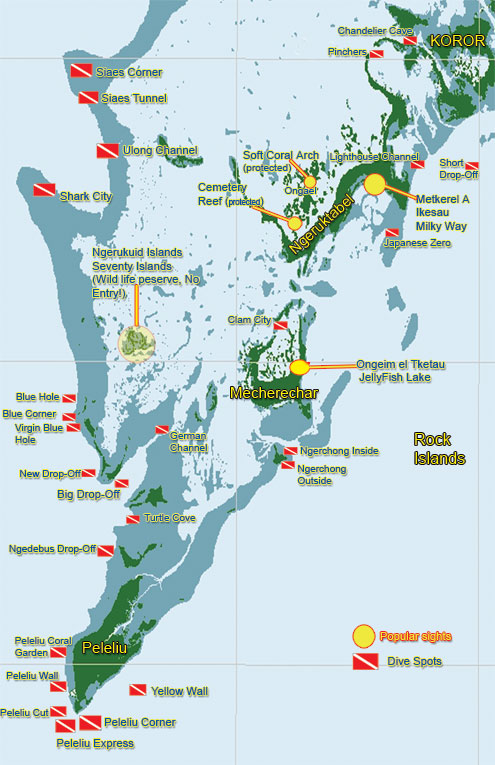Palau is that destination in Micronesia of which dreams are made. Here are a few of the amazing dive sites you can experience around this island paradise.
Blue Corner
Blue Corner is very possibly the highest-rated and best-known dive site on Earth. It is home to large permanent schools of barracuda, large numbers of fairly harmless grey, white-tip, and black-tip reef sharks, and sea turtles.
The dive site can best be described as a large flat triangle similar to the top of a large office building. Coral is not especially dense on this triangle; rather, its high density of animal life is supported by the plankton-rich water carried over it by strong currents. The omnipresent plankton reduces visibility to approximately 20m/60 feet which is typical in Palau, but roughly 1/3 lower than comparable but plankton-poor sites elsewhere in nearby Micronesia. The edges of the Blue Corner are dramatic vertical drops from this 50'-deep plateau to dramatic, un-SCUBAable depths. Typically, divers will drift along the outer edges, making brief forays onto the plateau. Photographers typically arm themselves with a "reef hook," so that their hands are left free while they take photographs in the strong current. Safety stops are typically done "on the fly"-- that is, while drifting out into blue, open water and maintaining neutral buoyancy without benefit of an anchor rope or ladder. This is popular as a "last dive of the vacation" and pinnacle of the tour for dive guides leading tourists, since its unparalleled level of sensory overload "spoils the customer" for less spectacular sites.
Chandelier Cave
Chandelier Cave is remarkably different from Palau's other dives, in that it is 1) a well-developed cave system, 2) almost coral-free, and 3) less than 5 minutes' boat ride from the nearest SCUBA companies' docks. Near the cave entrance on the shallow, flat, sheltered harbor floor, divers may be able to spot rare, shy Mandarin fish. The first and second caverns are as wide and tall as a small concert hall, but almost entirely under water and drably colored. Moving further back, however, there is a far smaller group of hotel room-sized chambers that are largely above water. The walls in these rearmost chambers are bright orange and white with numerous fragile crystal growths resembling sugar frosting on donuts. Divers are regularly permitted to enter these chambers, remove their SCUBA gear, and walk and crawl about as long as the divers are respectful of the cave's fragility.
Divers should not attempt to enter this area without an experienced guide and two light sources per diver.
Because Chandelier Cave is shallow, near many docks, and not reliant on sunlight to provide enjoyment to divers, this is an extremely popular spot for SCUBA divers who wish to make a third dive on a single day. Because it's in a very sheltered, shallow bay, it is also popular as a dive site when weather conditions make other sites un-divable.
Siaes Tunnel
Siaes Tunnel (pronounced like the English word "sighs") is a natural formation in a submerged coral wall drop-off. It is comparable in many respects to the Blue Hole in Guam (not to be confused with Palau's "Blue Hole"), although Siaes Tunnel differs in having far more abundant coral. The tunnel starts at a fairly shallow point and dives down steeply to a moderately deep exit point, and is wide enough to accommodate several divers swimming shoulder-to-shoulder. The tunnel was discovered by divers fairly recently (roughly a decade ago).
Turtle Cove
Turtle Cove is a vertical, virtually bottomless wall and one of the most popular standard dives in Palau. There is a boat mooring at the beginning, close to the wall. This, coupled with the exceedingly shallow, sandy flat area between the nearby rock island and the cliff make for a perfect lunch/rest/snorkelling area between dives. The dive itself is typically conducted as a multilevel dive, with the first portion at 60'/18m where the larger life (sharks, rays, large turtles) are, and gradually coming up shallower until the safety stop which is done while drifting along near the top edge of the underwater cliff. The shallow areas are filled with their own collection of smaller but equally dazzling life: smaller turtles (one yard / 1m long), abundant reef fish, gorgonian sea fans and so on. The current is seldom strong, so photographers can pause and do macro-lens photography without unusual effort.
Ulong Channel
Ulong Channel (pronounced like "ooh-long", much like Asian "oolong tea") is an ideal drift dive. Typically, dive boats wait until a strong outgoing tide, then deposit the divers in a 30~40'-deep bowl-like sandy area surrounded by a shallow, dense coral reef. The divers then ride the strong outgoing rip-tide along a 10~15-foot-wide sandy channel through the reef, travelling in excess of 10mph without swimming. Along this 40 minute joyride, one typically sees handfuls of smallish turtles, cabbage corals, and harmless young foot-long reef sharks. The depth is limited by the shallow, sand bottom of the riptide channel until one reaches the end of the ride, where one must quickly grab at a boat mooring rope along a cliff-like edge. This mooring rope is sometimes visited by large numbers of relatively harmless grey reef sharks, so what might otherwise have been a relatively boring safety stop at the end of a dive becomes an exciting opportunity with minimal effort. Except for the possibility of drifting into deep water at the end of the dive, this is an idyllic introduction to drift-diving and one of the best dives in Palau.

Text about the Palau dive sites courtesy of Wikipedia. Dive site map courtesy of Palau Visitor Authority. Other information courtesy of Palau Dive Adventures.